Whole Bloody Affair Adds Big O-Ren Ishii Duel to 'Kill Bill'
Spoiler Alert! The final cut's new anime sequence revealed
Though often billed as the “4th film by Quentin Tarantino,” Kill Bill (2003-2004) actually came out theatrically in two “volumes,” a division necessitated by the fact that the picture grew way too long for a traditional release. A big fan of both installments, I have been waiting for over 20 years now to see the full, single-film supercut version of the director’s postmodern martial arts opus.
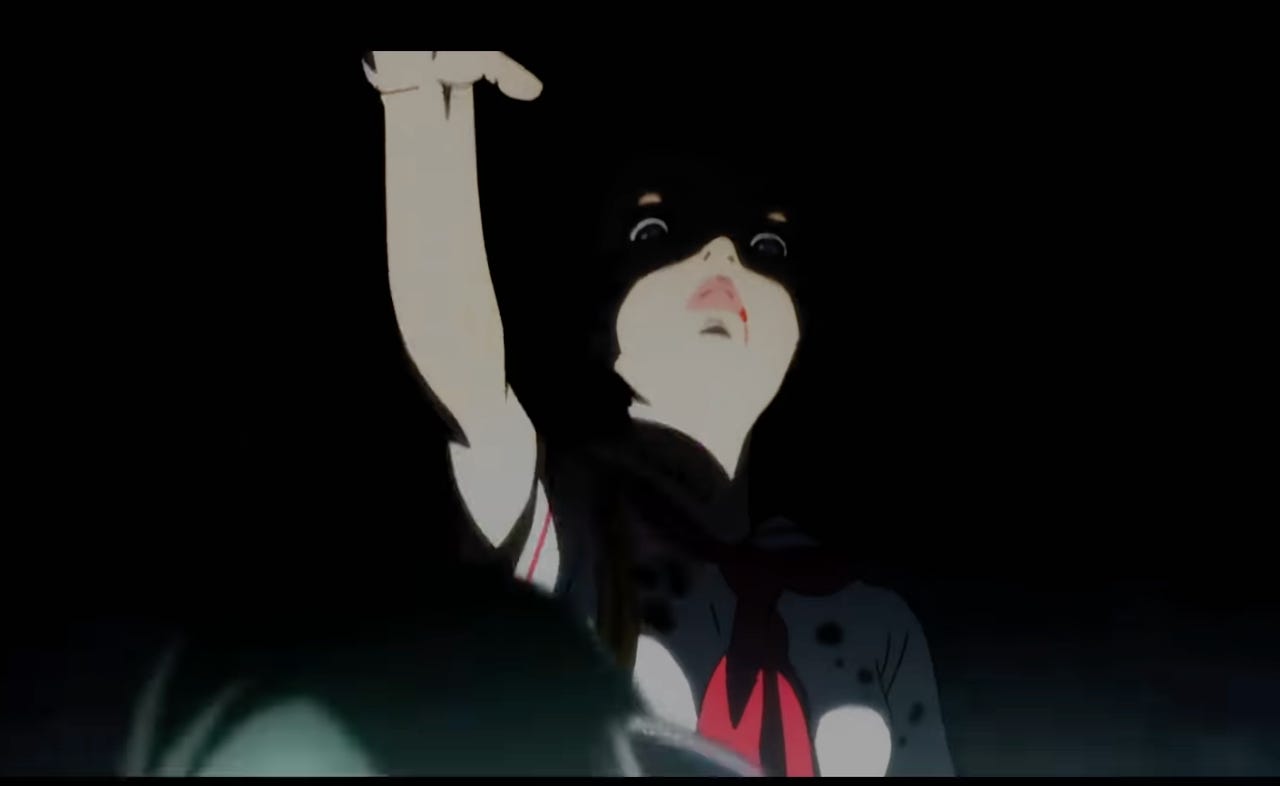
Subtitled The Whole Bloody Affair (TWBA), the 281-minute cut will premiere on December 5 in US theaters. In this article, I’m going to talk about the history of TWBA, its connection to the earlier Cannes Cut, as well as reveal what exactly happens in its new “never-before-seen 7.5-minute anime sequence,” which impacts the story of O-Ren Ishii, while debunking a (popular?) fan theory about Bill.
ContentsPlease consider subscribing and receive any new post for free via email, or upgrading to a paid subscription to support this publication.
The Young Bill Theory
When Kill Bill Volume 1 came out, one of its most fascinating sequences was in “Chapter 3: The Origin of O-Ren,” where the live-action film switches to Japanese animation for an extended 8-minute flashback that depicts the childhood tragedy that came to define Lucy Liu’s character, leading to her rise as an assassin.
The first scene shows a child O-Ren witnessing her parents’ murders at the hands of the Yakuza. We see her father fight and kill two Yakuza before getting impaled with a Katana through the back by a tall, long-haired assassin in a white suit. After her father falls to the ground, the assassin delivers another stab to finish him off.
This character is never identified in the film, but online he seems to be commonly referred to as Pretty Riki, so let’s go with that.
There are several interesting things about Riki.
For starters, he has a distinctive design that draws attention to itself. Unlike the other Yakuza, he is rather tall, wears a nearly all-white suit and is clearly the most capable and intimidating fighter. Not only is he the one who actually kills O-Ren’s father, but the film draws attention to this character by using an elaborate pan-up shot that tracks the Katana sword, showing us Riki’s rings. We even get a shot of O-Ren staring at Riki with hate in her eyes. And then, at the end, Riki even gets a cool mike drop move, where he kicks a burning cigarette butt that sets fire to the room.
All this makes Riki something more than just an anonymous Yakuza henchman. He stands out as a soldier villain and is set up as a kind-of ‘boss fight’ type character for O-Ren. But despite this, Riki then completely vanishes from the movie.
The next scene depicts O-Ren murdering Riki’s boss Matsumoto two years later, and so avenging the deaths of her parents before the last minute speedruns through her rise as an assassin up to the moment she participated in the massacre that left The Bride comatose. Riki’s absence from the rest of the flashbacks thus raises some interesting questions, such as: “Did Riki survive? And if so, why didn’t O-Ren ever go after him? Was killing Matsumoto enough for her?”
The lack of resolution to his character thus opened the door to the theory that Riki is actually a younger version of Bill (David Carradine), who would later recruit O-Ren into the DiVAS organization. If you’re a fan and you’ve attentively watched Volume 1 several times, then the thought might’ve very well crossed your mind, like it did mine.
Consider the evidence:
Bill could be Riki, because we never see Riki die, and movies regularly apply the law of conservation of character/detail.
Present-day Bill is certainly old enough to have worked for the Yakuza when O-Ren was a child.
Both are depicted as long-haired assassins, and there does seem to be some visual resemblance between them.
There are similar shots of them with their hands over a Katana.
Both wear distinctive rings - though not the same rings - in these shots, with the film’s cinematography arguably drawing a visual parallel between them.
There’s also the fact that Tarantino had plans for a Young Bill anime prequel.
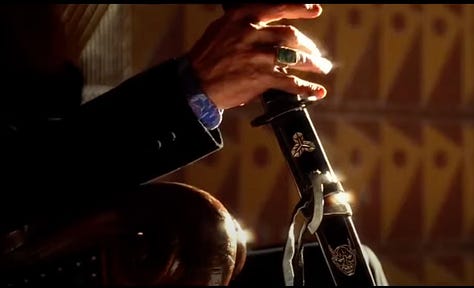

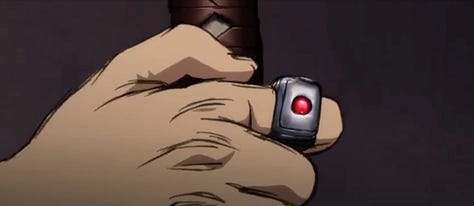
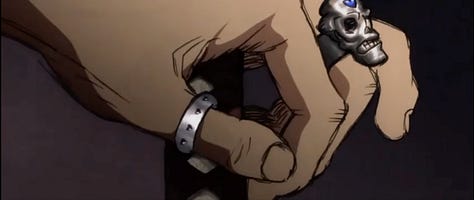
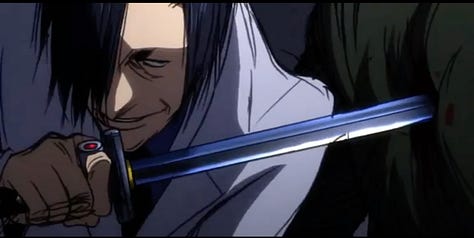
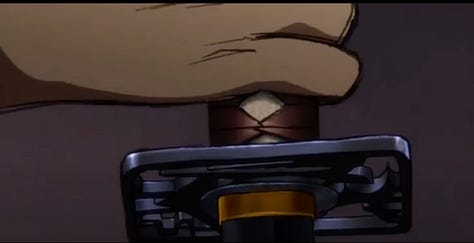
Having done some digging, I even found a forum page that cites an old imdb message board post from May 2004, according to which actor David Carradine ostensibly confirmed that the two were one and the same in an interview or at an event.
“He said that QT told him that the killer of O-Ren’s parents in the cartoon was indeed BILL. Apparently QT specifically requested this from the animators.
So the story would go, that O-Ren, becoming professional herself, forgives Bill as she understands that it was simply “business” and accepts his offer to work with him.”
Though the summary of Carradine’s interview does list a number of details that were accurate, such as the fact that a scene had been shot and cut with Michael Jai White and that Tarantino had plans for an animated prequel about a young Bill*, I was never able to find where exactly this supposed interview actually came from, nor to corroborate this via other interviews.
*That prequel would’ve focused on a young Bill’s relationship with three mentors: Esteban Vihaio, Hattori Hanzo, and Pai Mei. Like many other projects Tarantino had spoken off over the years, it would never come to fruition.
Following the release of Volume II, the question of whether or not Riki was a young Bill remained unresolved. The possibility was there, but there was no definitive proof to say one way or the other. As it turns out, the matter was to be settled in TWBA.
The Extended TWBA Anime Sequence
Why exactly did it take over 20 years for the full version of Kill Bill to get released?
It is difficult to say for certain. Tarantino often seemed to put it off to focus on other projects. Moreover, it seems that there were rights issues plaguing Volume 1 and Volume 2 and their various versions (eg. the ‘integral’ or Japanese Cut of Volume I) with the distribution getting a little messy or dispersed across different entities.
In practice though, the final cut was more or less ready 15-16 years ago.
Back in 2008, Uma Thurman stated in an interview about the Kill Bill anime projects:
“Right now he’s putting the two films together with an intermission with an added anime sequence he had already written,” she said of the ongoing saga of Beatrix Kiddo.
Source: Shawn Adler, MTV Movies Blog, April 22, 2008
In January 2009, Tarantino confirmed to the Quentin Tarantino Archives, a fan website, that a release of TWBA was indeed in the works and that it would feature a new 7-minute sequence in the O-Ren chapter, one that was apparently already scripted but had to be nixed due to the ballooning length of the movie.
““We’ve actually added some things to it. We did a whole little chapter that I wrote and designed for the animated sequence, that we never did, because we figured, back when it was gonna be one big movie, it was going to be too long, so we didn’t do it. So when we were talking about re-releasing it, they asked is there anything you can put in, and I said no I put everything in there, but… there’s one sequence that we wouldn’t even have to shoot! So we got together with Production IG and did it, and it’s really cool. So it’s this little seven minute sequence, it’s really cool, it’s in the O-Ren chapter.””
In August 2009, Tarantino claimed that he would finish up TWBA following the release of the upcoming Inglorious Basterds, adding that he still needed to do some work to finalize the new anime sequence by Production IG for the release.
“When I’m through with this, I can actually finish the final Kill Bill: The Whole Bloody Affair,” Tarantino told reporters Sunday in a group interview in Beverly Hills, Calif.
“I need to do one thing with it, though,” Tarantino said. “I’m not going to monkey around with the movie itself, but we’ve actually done a whole new section for the anime as the last thing [we added].”
Moreover, the director went on to specify that the extended anime sequence would actually depict an elaborate duel between O-Ren and Pretty Riki:
““I actually wrote a much longer script for the anime section during O-Ren’s revenge chapter. Remember the guy with the long hair that kills her father? It’s like, what happened to that dude? Well, I wrote it and it was the biggest, most elaborate thing I wrote—her taking him down.””
From the ScifiWire article by Todd Gilchrist, August 10 2009
Though he didn’t directly state it, Tarantino here more or less confirmed that Riki and Bill were separate characters. He would reiterate this about 5 years later in an interview with Collider, where he also discussed plans to release TWBA in 2015:
So you see in the movie [O-Ren] kill her boss but then there was that long hair guy... The big sequence was her fighting that guy. I.G. [The Japanese Anime Studio] who did Ghost in the Shell said we can’t do that and finish it in time for your thing… So we dropped it and then later when I.G. heard we were talking about doing Kill Bill: The Whole Bloody Affair -- they still had the script so without even being commissioned, they just did it and paid for it themselves…. The Weinstein Company and myself were talking about actually coming out with it sometime, not before the year is out, but within the next year with limited theatrical engagement as well.
One can infer that the new anime sequence was by this point fully finished, which is why Tarantino was now planning a theatrical release for TWBA. However, 2015 came and went, and nothing happened. News about TWBA then pretty much died.
I’m quite certain that the Weinstein Company announcing bankruptcy in 2018 and Tarantino filing a lawsuit against it further delayed the release. At some point between 2018 and 2023, Tarantino regained copyright to the film, allowing him to sign a new distribution deal for some of his movies with Lionsgate in May 2023.
This initially led to the remasters of Volume 1 and Volume 2, and is without a doubt why TWBA is now finally getting an unrated theatrical release on December 5.
The initial announcements all proudly proclaimed that the new version will finally feature a “never-before-seen 7.5-minute anime sequence,” with the recently released trailer explicitly confirming that this new footage is the lost O-Ren/Riki duel.
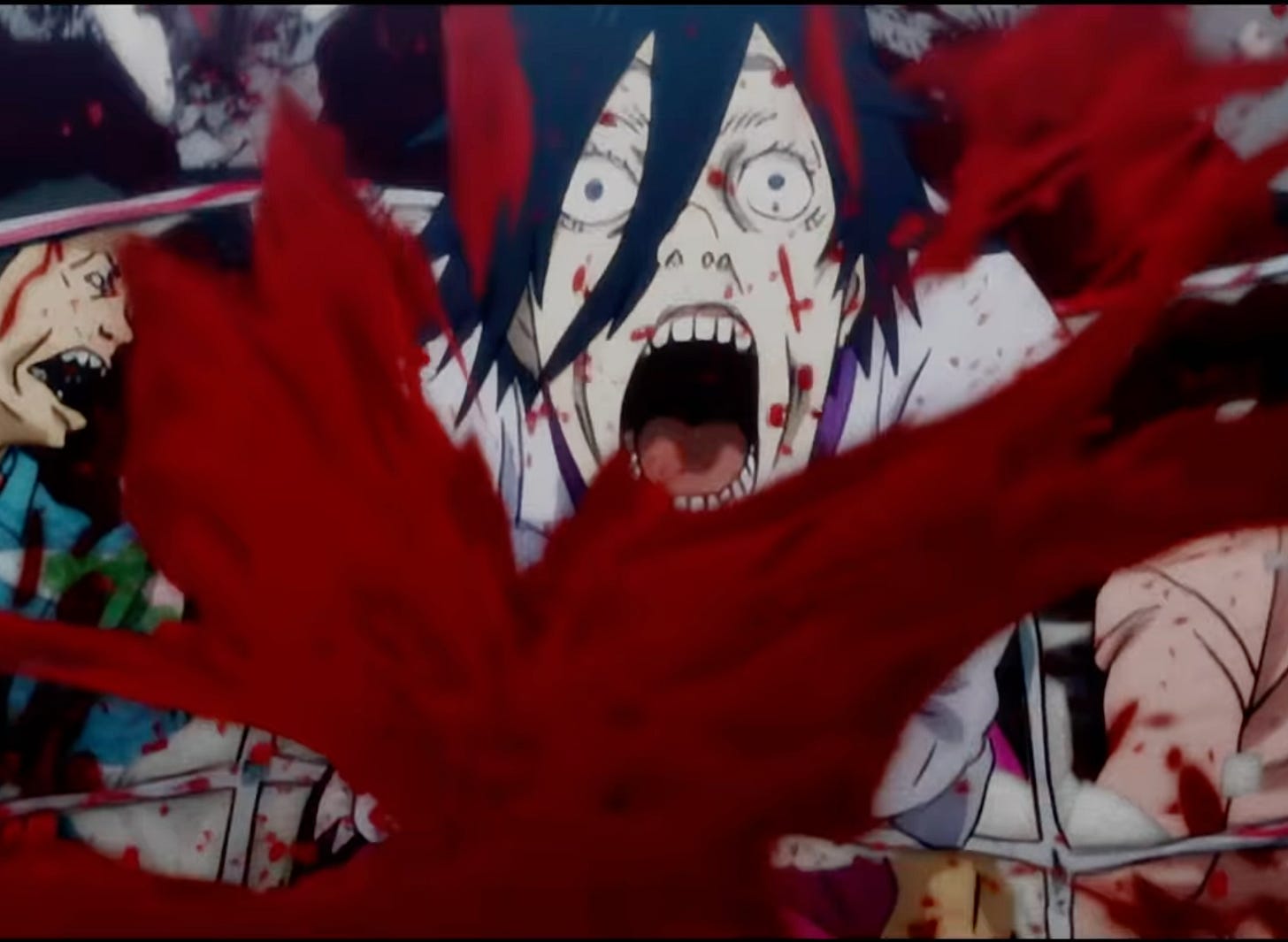
Now we have definitive proof that Bill and Riki are not one and the same. This means Bill did not kill O-Ren’s father before later recruiting her into his gang and that O-Ren really did get to complete her revenge, at least in the TWBA version of her story.
If Tarantino is to be believed, then the majority of the new 7.5 minutes will be entirely devoted to O-Ren dueling Pretty Riki. So, one can imagine a gloriously over-the-top action set piece that can only be made in anime.
But what about you?Did you ever think the young, long-haired killer in the anime was a young Bill? If so, what was your headcanon explanation for his relationship with O-Ren? Are you looking forward to the new anime sequence? Will you catch TWBA in theaters?
The Evolution and Revision of ‘Kill Bill’
“There is a lot of introspection, a lot of character development in VOLUME 2. Tarantino has always described Bill as a pimp of death. But there seems to be more to the man.
Yeah, quite a bit. As a professional, that’s what he does. He finds these young girls and turns them into assassins, controls them, and he likes to do it with beautiful women. And of course he gives his little brother a job. ”
Source: Interview with David Carradine for Phase 9 by Phase 9 Editorial, 16 April 2004.
To be honest, I am a little sad to finally have that enigma resolved, for even though it is a little farfetched that O-Ren would work for her father’s murderer, it would make sense with who Bill is as a person and would be a devilish twist to his relationship with O-Ren. I also wonder if perhaps at one point Riki and Bill were supposed to be the same character but Tarantino later changed his mind.
This certainly seems possible when you consider how fluid and subject to change the film was all throughout development, production and post-production. Tarantino kept adding, modifying and rewriting scenes during the shoot. For instance, the film was to end with a swordfight between the Bride and Bill on a beach before getting pared down to her quickly besting him with the five-point-palm technique in his home.*
*Though I can’t find it right now, I do recall reading a draft where this was described as an elaborate battle, with the Bride using the Hanzo style and the Pai Mei styles of martial arts.
The decision to split the film up into two parts for distribution purposes also required creating a cliffhanger ending for Volume I as well as a new opening sequence for Volume II, so that each could work better as a standalone unit of storytelling.
Initially, the first volume was going to end with a reveal of Bill’s face. But Tarantino ultimately decided to hold off on this until the beginning of Volume II. Ironically enough, the original teaser trailer had already spoiled what Bill looked like!
...I had heard there was enough footage shot that there could have been a third film.
DC: The original idea was for two 90-minute movies, which ended up with the first film over 90- Minutes and the second over 2 hours and twenty minutes. There was always the plan to shoot extra scenes. For example, I do not have a scene with Daryl Hannah and we wanted to have something that would show how our relationship happened.
Source: Interview with David Carradine for Skewed and Reviewed, by simeon, June 21, 2008.
“According to Carradine… the set of Kill Bill was a testing ground for tinkering, revising, and experimenting. “Most of the time (during filmmaking),” Carradine laments, extending his cigarette with jade-ringed fingers, “the director has a preconceived notion of what he’s gonna do.… But Quentin is open to changing with the wind, and he did it with his writing right up until the very end. That whole final monologue changed, like five times. The last time it changed was the day that I came in to do it!… There was one point, where there was a close-up of me at the end of the first movie. Then, (Tarantino) took that back out and thought, “I’m gonna keep this a complete mystery (until the second film).
Source: Interview with David Carradine by KJ Doughton for NitrateOnline.com , 16 April 2003.
Then, he ended up producing multiple cuts of each volume for different markets.
Did you know, for example, that there is a longer, bloodier and gorier Japanese Cut of Volume I? It opens with a dedication to filmmaker Kinji Fukasaku, replacing the “old Klingon proverb” title card and presents the House of Blue Leaves fight sequence, where the Bride faces off against the Crazy 88, completely in color and uncensored. Tarantino, as it turns out, cut many bits out and transitioned part of it into black-and-white to help Volume I avoid an NC-17 rating for the US theatrical release.*
*On a side note, I remember hacking and modifying my computer’s DVD drive about 20 years ago just so I could play the Region 2 DVD of Kill Bill Volume 1 and watch the extended cut.
The Japanese Cut of Volume II similarly contains some differences from the US theatrical version, though these are very minor. Moreover, Tarantino has indicated that there are differences between the European and American cuts of the films as well though I don’t believe these have ever been reported.
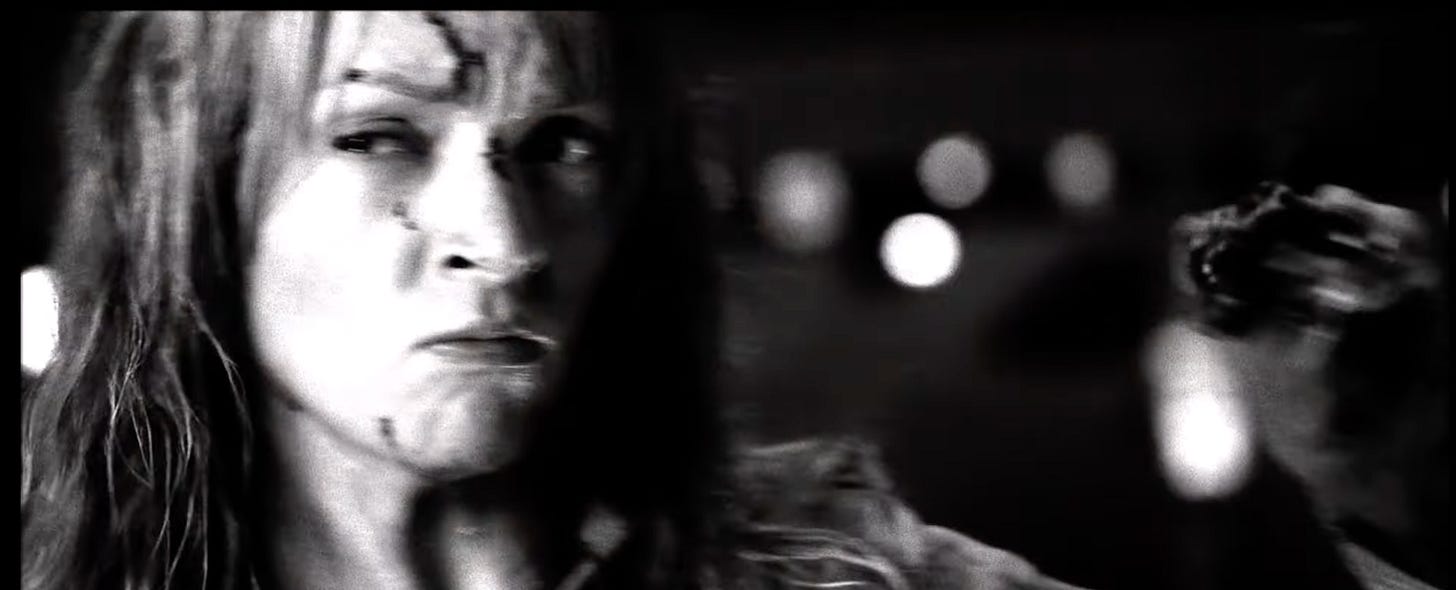
Is it true that there are different versions of Kill Bill?QT: That’s the most interesting thing about making this movie. There is no definitive version. There are different versions. Each one plays differently. I’ll give you an example. There is a Japanese version and an American and European version. If you put the two movies together, that’s a different movie. If I were able to put one chapter from the Kill Bill series in the theatres, say on a weekly basis, by the time you got to the end of the last chapter, you would have seen Kill Bill and it would not have been compromised. I cannot think of another film that I have made or will ever make that will be so malleable.
Source: Interview with Quentin Tarantino by Alberlynne “Abby” Harris for BlackFilm.com, April 2004.
Given that the anticipation of the ultimate showdown is so high, is there any way to avoid somewhat of an anti-climax?
I don’t think it is an anti-climax, but Quentin wanted to surprise, and he certainly did. The way that we do it, and I don’t want to reveal it, but in the original script that I read there’s a totally different kind of battle, let’s say, at the end than what we did. And I came on to the set and all of sudden everything was changed and I had twenty minutes to learn the battle, and it was the funniest damn idea I have ever heard of, what Quentin decided to do – and that’s Quentin.
Source: Interview with David Carradine for Phase 9 by Phase 9 Editorial, 16 April 2004.
When you take all this into consideration, it becomes obvious that all the stuff about how the 281-minute TWBA was always how Kill Bill was “intended” to be seen is just marketing hyperbole. TWBA may be the final cut, but it’s not really definitive. Regard-less, I’m looking forward to seeing it on the big screen next month and then getting the Blu-Ray (assuming it’s released on video), especially as this is likely the last project we’ll ever see in the Kill Bill universe.* Though I also hope that it’s so successful that it motivates Tarantino to finally finish the Django Unchained director’s cut.
* I highly doubt that at this point any of the planned anime prequels or sequels are likely to ever materialize.
On The Cannes Cut
Contrary to popular belief (and advertising), Kill Bill: The Whole Bloody Affair has never actually been shown before to the general public. What has been shown (most notably at Tarantino’s own New Beverly Cinema) over the past 21 years, yet erroneously advertised as “The Whole Bloody Affair,” is the Cannes Cut, which was first screened for critics at the Cannes Film Festival in 2004.*
*Some say it was 2006, but 2004 seems to be the correct year based on my research.
Combining the two volumes into a single film, it included many differences from the two US theatrical cuts of Volumes I and II respectively. These include:
Alternate and additional footage from the extended Japanese Cut of Volume I
The lack of the ‘bookend’ sequence that closes Volume I while previewing Volume II. Consequently, the audience thus does not become aware that the Bride’s daughter is alive until the very end of Volume 2, making it a surprise twist.
While I can’t confirm it, I strongly suspect that the opening b/w car driving scene of Volume II, where the Bride breaks the fourth wall and talks about how the previous movie was described as a ‘roaring rampage of revenge,’ was also cut. It simply doesn’t make sense to include it unless Volume II is presented by itself.
Ditto for the car driving credits of Volume II, which were already redundant given the presence of the complete credit sequence for both parts.
A musical intermission between the two volumes
French subtitles
Based on all the available info released thus far, it seems that Tarantino had long intended to use the Cannes Cut as the base for TWBA, with the only difference between the two being the addition of the animated O-Ren duel sequence.
But I wouldn’t be surprised if the director had made some more little tweaks here and there, given the 21-year gap between the Cannes Cut and the “final” cut.
But what about you?What do you think of Kill Bill? How do you rank it against Tarantino’s other films? Have you ever seen the Cannes Cut? Do you like it more or less than the two-volume release? Do you think Kill Bill should really count as one movie or two different films?



This is an incredibly well written post about one of the greatest flicks ever made! Thank you for brining us up to speed. I'm most definitely going to see THBA!! Will probably get an entire crew together to go see it, minus the katanas lol
So wait, there is NO CUT with Michael Jai White??